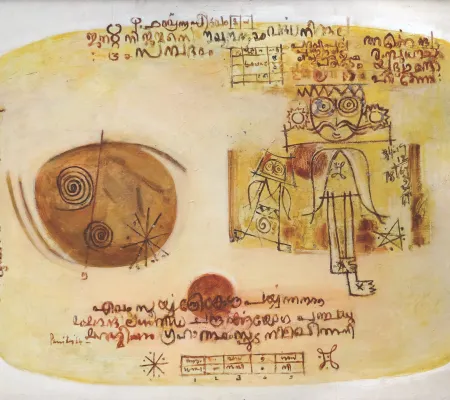In 1963, the eminent painter KCS Paniker, then Principal of the Madras School of Art, shifted his idiom to incorporate diagrams, mathematical equations, snippets of Malayalam text, and a range of symbolic elements from a wide range of source material. He called these paintings Words and Symbols. In one of the first works after this transformation, Paniker embedded his own birth chart, directly incorporating both autobiography and astrology as key references.
Rather than unpacking these works’ multilayered iconographies and mapping the symbols onto various external referents, perhaps with an eye to developing a reading via a Panofsky-inspired iconology—I propose to engage with Paniker’s work by taking seriously the astrology that inaugurates it. Following recent art historical engagements with a method via constellation (particularly Alex Seggerman’s on Egyptian modernism), I think through Paniker’s Words and Symbols paintings via constellations of relation, whether with artists’ experimentations with partially or wholly asemic writing, his own son’s sculptural engagement with color and form, or with the writing of critics and artists close to home in Madras, like Josef James, or further afield in both time and geography, like Paul Klee.
Constellational modes of thinking about relation stem from the writings of Walter Benjamin via Adorno; here I push this framing further—into astrology—an epistemology with its own histories embedded within southern Indian practices and, tellingly, Euro-American canonical art historiography via Aby Warburg and Ernst Gombrich. How do we grapple with Paniker’s turn to writing and symbol, his encounters with works and individuals in India, the US, the USSR, the UK, and Europe? How do we take seriously his engagement with Paul Klee, Wassily Kandinsky, Vincent Van Gogh, Henri Bonnard, and others while maintaining a balance with the larger cosmos of his artistic relations and thinking? And what happens to art historical approaches in taking constellations and astrology as frameworks for analysis?
Rebecca M. Brown is a Professor in the Department of the History of Art and Chair of the Advanced Academic Programs in Museum Studies and Cultural Heritage Management at Johns Hopkins University. Brown’s research engages in the history of art, architecture, and visual culture of South Asia from the late eighteenth century to the present. She has published numerous articles and three books on the early British presence on the subcontinent, the anti-colonial movement of the early twentieth century (Gandhi’s Spinning Wheel and the Making of India, Routledge 2010), art in the decades after India’s independence in 1947 (Art for a Modern India, Duke 2009), and the economic and political machinations of the long 1980s (Displaying Time: The Many Temporalities of the Festival of India, Washington 2017). Her current research focuses on the painter KCS Paniker (1911–77) and his his search for a language of painting in the 1960s and 1970s. Other interests extend to contemporary photography via the work of Dayanita Singh and Annu Palakunnathu Matthew, and to the decolonizing maneuvers of the sculpture–installations of Rina Banerjee.


